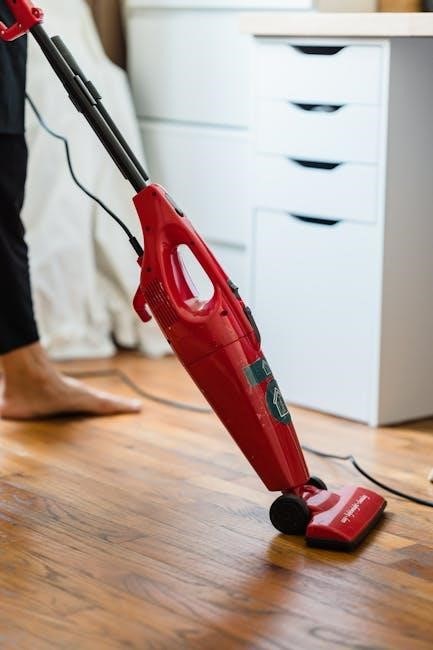
manual push vacuum
Manual push vacuums are portable, manual cleaning devices designed for quick pickups. They are ideal for small spaces and offer a simple, eco-friendly alternative to electric vacuums without the noise.
What is a Manual Push Vacuum?
A manual push vacuum is a lightweight, portable cleaning tool designed for quick pickups without electricity. It uses manual pushing to create suction, capturing dust, debris, and small particles effectively. Unlike traditional electric vacuums, it relies on physical effort, making it eco-friendly and cost-effective. Ideal for small spaces, hard floors, and low-pile carpets, it’s a practical solution for maintaining cleanliness with minimal effort. Its compact design and ease of use make it a popular choice for everyday tidying in homes, offices, and vehicles. This simple yet efficient device offers a hassle-free alternative to bulky cleaning equipment, ensuring a neat environment with minimal environmental impact.
History and Evolution of Manual Push Vacuums
Manual push vacuums have a long history, dating back to the early 20th century when manual cleaning tools first emerged. Initially, they were basic suction devices with limited efficiency. Over time, advancements in design and materials led to improved performance. The introduction of lightweight materials like stainless steel and plastic made them more accessible and durable. Modern manual push vacuums have evolved to include ergonomic handles, adjustable nozzles, and enhanced suction power, making them more efficient and user-friendly. Their popularity grew as a cost-effective, eco-friendly alternative to electric vacuums. Today, they are widely used for quick cleanups in homes, offices, and vehicles, offering a practical solution for everyday maintenance.
How Manual Push Vacuums Work
Manual push vacuums use a manual pump to create suction, capturing debris in a collection chamber. They rely on repeated pressing and releasing motion for cleaning efficiency.
Mechanism and Components
A manual push vacuum operates through a simple mechanism involving a few key components. The primary parts include a collection chamber, a plunger or piston, and a valve system. When the user pushes the device, the piston creates negative pressure, drawing debris into the chamber. The valve ensures air flows in one direction, maintaining suction. Some models include filters to trap dust particles. The design is lightweight and compact, making it easy to maneuver. Optional features like adjustable nozzles or crevice tools enhance versatility. This straightforward engineering allows for effective cleaning without electricity, relying solely on manual effort and basic physics principles.
Operation and Efficiency
Manual push vacuums function by creating suction through manual effort, eliminating the need for electricity. They are highly efficient for quick cleanups, particularly on hard floors, carpets, and small surfaces. The device is pushed forward, generating negative pressure that lifts debris into the collection chamber. Their lightweight design and ease of use make them ideal for daily maintenance. These vacuums are quiet and produce no emissions, offering an eco-friendly cleaning solution. While they may lack the power of electric vacuums, their portability and simplicity make them a practical choice for spill cleanup and tight spaces, ensuring efficient results with minimal effort.

Benefits of Using a Manual Push Vacuum
Manual push vacuums are eco-friendly, cost-effective, and lightweight, offering quiet operation and ease of use. They provide a practical solution for quick cleanups without electricity, enhancing daily maintenance efficiency.

Advantages Over Traditional Cleaning Methods
Manual push vacuums offer several advantages over traditional cleaning methods. They are lightweight and portable, making them easy to maneuver in tight spaces. Unlike electric vacuums, they require no electricity, reducing energy consumption and operational costs. This eco-friendly feature appeals to environmentally conscious users. Additionally, manual push vacuums are quieter, making them ideal for noise-sensitive environments. They also eliminate the need for costly filters and replacement parts, lowering maintenance expenses. Furthermore, these vacuums promote physical activity, as the user engages in light exercise while operating them. Their simplicity and efficiency make them a preferred choice for quick cleanups without the hassle of cords or batteries, while providing a cost-effective solution for maintaining cleanliness in various settings.
Environmental and Cost Efficiency
Manual push vacuums are highly environmentally and cost-efficient cleaning tools. They operate without electricity, significantly reducing energy consumption and lowering carbon footprints. This makes them an eco-friendly alternative to traditional electric vacuums. Additionally, they require minimal maintenance and have no filters or disposable parts, reducing waste and long-term costs. The absence of electric components also means fewer resources are needed for production, further benefiting the environment. From a financial perspective, these vacuums are often more affordable than electric models and have no ongoing energy or replacement costs. Their durability ensures a long lifespan, making them a sustainable and economical choice for everyday cleaning needs while promoting energy conservation and reducing household expenses.
Maintenance and Troubleshooting
Regular cleaning and inspection of manual push vacuums ensure optimal performance. Troubleshooting common issues like blockages or suction loss can be resolved with simple maintenance tasks.

Regular Maintenance Tips

Regular maintenance is crucial for extending the life and efficiency of manual push vacuums. Start by emptying the dustbin after each use to prevent dust buildup. Clean the filter regularly, as a clogged filter can reduce suction power. Use a soft brush or cloth to wipe down the exterior and remove any debris. Check for blockages in the nozzle or hose, and clear them promptly. Lubricate moving parts if necessary, and store the vacuum in a dry, cool place. Performing these tasks ensures consistent performance and prevents common issues from arising.
Common Issues and Solutions
Manual push vacuums are generally reliable, but occasional issues may arise. One common problem is blockages in the nozzle or hose, which can be resolved by disassembling and clearing debris; Another issue is reduced suction power, often caused by a dusty or clogged filter. Cleaning or replacing the filter typically restores performance. Some users may experience difficulty in emptying the dustbin, which can be addressed by ensuring it is completely emptied after each use. Additionally, worn or loose seals can reduce efficiency, so inspecting and replacing them as needed is recommended. Addressing these issues promptly ensures optimal functionality and extends the vacuum’s lifespan.

Safety Precautions and Best Practices
Always ensure the floor is clear of debris and tripping hazards. Avoid using near water or on uneven surfaces. Store upright and out of reach of children.
Safe Usage Guidelines
Always clear the area of loose objects and ensure the surface is dry and even. Avoid using manual push vacuums near water or on uneven floors to prevent accidents. Check for blockages regularly to maintain efficiency and prevent damage. Use gentle pressure to avoid straining or causing injury. For delicate surfaces, test a small area first to ensure compatibility. Never use the vacuum near open flames or sparks, as dust particles could ignite. Store the vacuum upright in a dry place, out of reach of children. Regularly inspect the brush and wheels for wear and tear to ensure safe operation.
Storage and Handling Tips
Store your manual push vacuum in a dry, clean, and stable location to prevent damage. Keep it upright to save space and avoid dust accumulation. Avoid extreme temperatures and moisture, which can harm the materials. Before storing, clean the vacuum to prevent dirt buildup. Handle it gently to avoid breaking parts like wheels or brushes. Store it in a convenient, accessible spot to avoid damage when retrieving it. Ensure it’s not crushed by other items. Regularly inspect for wear and tear before and after storage to maintain its condition. Following these tips will extend the life of your manual push vacuum and ensure effective performance.